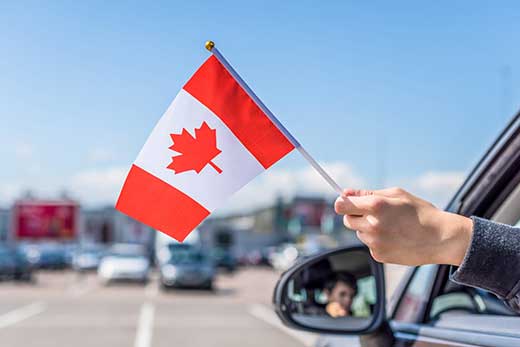
Average Car Insurance Rates Across Canadian Provinces (Updated for 2024)
Car insurance rates vary widely across Canada, and understanding the reasons behind these differences can help you manage your budget.
In this updated guide for 2024, we’ll explore how car insurance works across the country and take a closer look at what’s happening with rates in Alberta.
Insurance Costs By Province
Car insurance rates vary significantly across Canada due to differences in provincial regulations, accident rates, and coverage systems.
Factors like the type of coverage system (no-fault vs. full tort), legal environments, and regional accident statistics also play key roles in shaping these rates.
Alberta – $3151 Average Annual Premium
Alberta car insurance rates are the third most expensive in Canada, experiencing a $300 increase since 2015.
- Insurance expenses only account for 2.7% of disposable income.
- Previously, insurers could only face a rate increase of 5% per year, but this cap was removed in 2019.
Nova Scotia – $2491 Average Annual Premium
Nova Scotians have benefited from lower car insurance rates since reforms in 2003.
Driving history plays a significant factor in car insurance rates, and coverage can affect an insurance premium by up to 30%.
- Nova Scotia experiences a lower number of accident claims per year compared to the rest of Canada.
- Nova Scotia rewards safe drivers with lower insurance premiums.
Ontario – $2299 Average Annual Premium
Ontario is one of the most populated provinces in Canada and the second most expensive for auto insurance.
Experts indicate that the main cause of recent rate hikes is the high frequency of claims, lawsuits, and injuries.
- There are also high levels of insurance fraud and organized crime that impact private insurance companies.
- Overall, Ontario’s higher rates can be attributed to the fact that this province has the most drivers in the country.
New Brunswick – $2187 Average Annual Premium
New Brunswick used to enjoy even lower rates, but an increase in claims (largely due to distracted driving) has driven prices in the past few years.
- Auto insurance in New Brunswick accounts for 2.8% of after-tax disposable income – the lowest percentage after Alberta.
- Insurance reforms in New Brunswick maintain premiums on the lower end of the scale and reward safe drivers.
Newfoundland and Labrador – $2162 Average Annual Premium
Even though Newfoundland and Labrador have a comparatively small population, they have experienced some of the biggest rate jumps in the country.
This is because this province operates under the “tort” system, where you can sue an at-fault driver for injuries, lost wages, and other damages.
- Rising rates are largely blamed on increased accident claims and vehicle-related lawsuits.
- Newfoundland and Labrador offer only private insurance options, so rates are competitive.
British Columbia – $1775 Average Annual Premium
British Columbia’s insurance is run by a crown corporation, so there is no comparing rates to save money.
- BC runs a break-even profit system, but operational costs often outdo revenues.
- In the spring of 2021, the Insurance Corporation of British Columbia reduced premiums by around 20%.
Prince Edward Island – $1703 Average Annual Premium
Prince Edward Island relies on private insurance, which has kept rates low for many years.
Plus, PEI has one of the lowest rates of accidents in the nation, so there are fewer claims to pay out.
- PEI has one of the most efficient privatized car insurance systems in Canada.
- Rates remain low due to competition and a decrease in auto insurance claims each year.
Manitoba – $1373 Average Annual Premium
Manitoba operates similarly to British Columbia, with a crown corporation issuing car insurance. Therefore, there is no shopping around for insurance if you don’t like the rates.
- In 2021, the province agreed to reduce auto insurance rates by 8.8%.
- Despite its high insurance rates, it is still considered middle-of-the-road compared to the other Canadian provinces.
Saskatchewan – $1249 Average Annual Premium
Saskatchewan relies on a provincially-run insurance agency, so there is no shopping around in this province as well.
Plus, all drivers are required to carry third-party liability insurance up to $200,000
- Saskatchewan only takes driving records into consideration when determining rates – they do not consider age, gender, or location.
- A significant portion of Saskatchewan drivers are considered to be underinsured.
Quebec – $1112 Average Annual Premium
Quebec has the least expensive insurance premiums of all the Canadian provinces. Rates are not increasing at the same pace as in other provinces.
Because Quebec’s insurance regulations are not as strict as other provinces, rates remain low.
- The combination of private and public insurance in Quebec allows for additional coverage on top of basic insurance packages.
- The no-fault system for accidents limits liability and reduces the overall cost of insurance.
How Does Insurance Work in Canada?
Canada’s car insurance system differs by province, and the mix of public and private options can affect how much you pay.
Here’s a breakdown of the different types of insurance available across the country:
Public Insurance
In some provinces, car insurance is publicly run. This means the government provides basic coverage to all drivers, often with fewer choices for optional coverage.
Provinces like British Columbia and Manitoba have publicly funded insurance systems, where drivers must get their mandatory coverage from the government.
Private Insurance
Other provinces, such as Ontario and Alberta, rely on private insurers to offer coverage. Drivers can shop around for policies, allowing for more competitive rates in some areas.
While this system offers more choice, prices can fluctuate based on factors like market competition and individual driving records.
No-Fault Insurance
No-fault insurance is another key aspect in many provinces.
This system allows drivers to file claims with their own insurance company after an accident, regardless of who was at fault.
It helps streamline the claims process and reduces the need for lawsuits, which can lower rates in some regions.
Full Tort Insurance
Full tort insurance allows drivers to seek compensation through legal action if they’re injured in an accident.
While this offers more avenues for compensation, it can also lead to higher premiums, as insurance companies account for the potential cost of lawsuits.
What’s Happening With Insurance Rates in Alberta?
Alberta’s car insurance market has been a hot topic lately, with various factors contributing to rising premiums.
Here’s a closer look at some of the key issues affecting rates in 2024:
Inflation
The rising cost of goods and services is putting pressure on car insurance rates in Alberta.
Repair costs, medical expenses, and even vehicle prices have all been climbing, making it more expensive for insurers to cover claims.
This increase in costs is being passed on to consumers, resulting in higher premiums.
Law Suits and Injuries
Alberta’s insurance market allows for legal claims related to car accidents, and this has an impact on premiums.
Legal fees and injury compensation contribute to the overall cost of insurance, especially in more serious accident cases.
As the number of claims rises, so do the associated costs, which insurers reflect in their pricing.
Driving Levels Are Back to Normal
During the pandemic, fewer people were on the roads, which led to a temporary decrease in accidents and claims.
Now that driving levels are back to normal, the number of accidents has also returned to pre-pandemic levels.
This increase in claims has driven up the costs for insurers, pushing premiums higher for Alberta drivers.
Average Premiums and Rate Trends
Average written premiums—what consumers pay—have been relatively stable in recent years.
According to the Insurance Bureau of Canada (IBC), these figures are derived by averaging monthly vehicle and written premium data and then dividing premiums by the number of vehicles.
The estimated 2024 premium is projected to rise, continuing the trend seen in previous years, with factors like rate caps, reforms, and pauses affecting the pricing landscape.
How to Save Money On Your Car Insurance
While you can’t change the average annual premium in the province you call home, there are certain things you can do to lower the cost of your car insurance:
- Increase the deductible amount for your claims to lower your premiums.
- Consider dropping collision coverage if you own an older car.
- Combine your car insurance with your home insurance.
- Check out usage-based insurance.
- Take a driver’s training course.
- Keep your driving record clean.
- Consider the vehicle you are purchasing since some vehicles are cheaper to insure than others.
- Drive your vehicle less to quality for low-mileage discounts.
If you live in a province with privatized insurance, the most important thing you can do to reduce your rates is to shop around for better insurance rates.
Drive Down Your Car Insurance Costs with Arc Insurance
ARC Insurance is proud to offer a variety of insurance solutions in the Edmonton area!
Our expert team of brokers is ready and available to provide you with a quote or to answer any questions you may have.
Your insurance policy shouldn’t break the bank or prevent you from purchasing a vehicle.
Get in touch today for the perfect insurance product to meet your unique needs.


